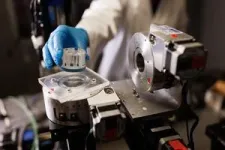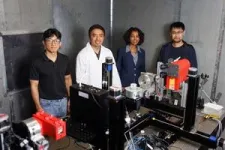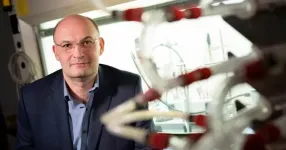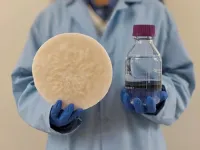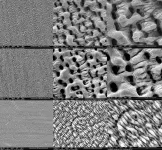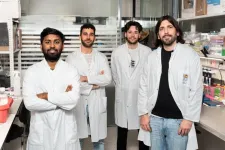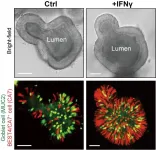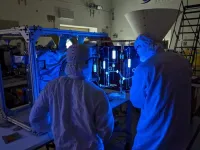(Press-News.org) New technology developed by researchers at the University of Houston could revolutionize medical imaging and lead to faster, more precise and more cost-effective alternatives to traditional diagnostic methods.
For years, doctors have relied on conventional 2D X-rays to diagnose common bone fractures, but small breaks or soft tissue damage like cancers often go undetected. More expensive and time-consuming MRI scans are not always suitable for these tasks in these detection or screening settings. Now, Mini Das, Moores professor at UH’s College of Natural Sciences and Mathematics and Cullen College of Engineering, has developed a 3D solution.
In a paper featured on the cover of the Journal of Medical Imaging, Das explains how photon counting detectors along with novel algorithms allow for more precise 3D visualization of different tissues and contrast agents by capturing X-rays at multiple energy levels simultaneously, which helps differentiate materials inside the body.
“Right now, X-rays used in medical clinics and other industries collect incoming photons as a whole, similar to how white light contains all the colors, but they aren’t separated,” Das says. “So, while they can show differences in density – like distinguishing between bone and soft tissue – they can’t tell us exactly what materials are present.”
The photon counting detectors developed by Das’s team at UH can separate X-ray photons by their energy levels, similar to how a prism splits white light into different colors – and they can help identify specific materials, such as distinguishing between aluminum, plastic, iodine or other contrast agents like gadolinium used in medical imaging.
“This could improve cancer detection, for example,” Das says. “If you inject two different contrast agents – one targeting a tumor and another targeting inflammation – you could see where each one accumulates. Right now, we can see bright areas in an image, but we can’t always tell what they are. This technology would give us a much clearer, quantitative analysis. It would allow us to determine not just what’s inside an object, but what different materials are present and in what quantities.”
However, even with this advanced detection, some materials have similar X-ray properties, so distinguishing more than two or three at once can be a challenge. This is also amplified due to errors in the detectors as they separate photons by energy. But Das is working on a solution to that problem.
“We have developed a method that compensates for these detector distortions by calibrating the detector using known materials,” Das says. “Once corrected, we can use the data along with the proposed novel algorithm, for accurate material decomposition – breaking down an image into its component materials. We do this in a multi-step solution from the same CT data collected improving accuracy.”
Before the detectors can be widely used, there is still a lot of work to do. But Das says her team is working with industry partners in Europe to develop larger versions of these novel detectors and optimize their performance.
“We’re still in the research and development phase,” Das says. “Right now, the detectors are small, and we need to refine their measurement accuracy. But once we solve those challenges, we can begin testing in real-world medical and industrial settings. There are so many other potential applications for this technology including in materials imaging, baggage scanning for security, imaging for geophysics, and micro- and nano-electronics imaging – it’s very promising.”
Previously, Das addressed a century-old problem in another innovative area related to the exploration of the wave nature of X-rays to significantly enhance soft material contrast. This research was featured in the prestigious scientific journal Optica featured in the prestigious scientific journal Optica last year.
Das’s research is funded through multiple agencies including NSF, CDMRP and NIH. The latest funding from the National Institute of Biomedical Imaging and Bioengineering aims to develop low-dose Micro-CT that utilizes multiple novel contrast mechanisms, thereby reducing radiation dose and imaging time which continues to be a significant issue.
END
University of Houston researchers paving the way for new era in medical imaging
Photon counting detectors promise fast color X-ray images
2025-02-25
ELSE PRESS RELEASES FROM THIS DATE:
High-tech startup CrySyst provides quality-by-control solutions for pharmaceutical, fine chemical industries
2025-02-25
WEST LAFAYETTE, Ind. — International process systems and operation experts have launched high-tech startup Crystallization Systems Technology Inc. (CrySyst) to streamline processes used by companies in the pharmaceutical and fine chemical industries.
CrySyst’s quality-by-control (QbC) framework addresses crystallization monitoring, modeling and control. The framework is based on research published in the April 15, 2020, and Oct. 5, 2021, issues of the journal Crystal Growth & Design and the Sept. 22, 2022, issue of the journal Industrial & Engineering ...
From scraps to sips: Everyday biomass produces drinking water from thin air
2025-02-25
Discarded food scraps, stray branches, seashells and many other natural materials are key ingredients in a new system that can pull drinkable water out of thin air developed by researchers from The University of Texas at Austin.
This new “molecularly functionalized biomass hydrogels” system can convert a wide range of natural products into sorbents, materials that absorb liquids. By combining these sorbents with mild heat, the researchers can harvest gallons of drinkable water out of the atmosphere, even in dry conditions.
“With ...
Scientists design novel battery that runs on atomic waste
2025-02-25
COLUMBUS, Ohio – Researchers have developed a battery that can convert nuclear energy into electricity via light emission, a new study suggests.
Nuclear power plants, which generate about 20% of all electricity produced in the United States, produce almost no greenhouse gas emissions. However, these systems do create radioactive waste, which can be dangerous to human health and the environment. Safely disposing of this waste can be challenging.
Using a combination of scintillator crystals, high-density materials that emit light when they absorb radiation, and solar cells, the team, led by researchers from The Ohio State University, demonstrated that ambient ...
“Ultra-rapid” testing unlocks cancer genetics in the operating room
2025-02-25
A novel tool for rapidly identifying the genetic “fingerprints” of cancer cells may enable future surgeons to more accurately remove brain tumors while a patient is in the operating room, new research reveals. Many cancer types can be identified by certain mutations, changes in the instructions encoded in the DNA of the abnormal cells.
Led by a research team from NYU Langone Health, the new study describes the development of Ultra-Rapid droplet digital PCR, or UR-ddPCR, which the team found can measure the level of tumor cells in a tissue sample ...
Mimicking shark skin to create clean cutting boards
2025-02-25
WASHINGTON, Feb. 25, 2025 – Keeping work surfaces clean during meat processing is a challenge. Bacteria from meat can attach, grow, and build up to create a biofilm that is difficult to remove, even on stainless steel surfaces used in industrial facilities. It can also aggregate, clumping together into an invisible mass that is stronger than individual cells, making it harder to kill using food-grade antibacterial surface cleaners.
In a paper published this week in Journal of Laser Applications, from AIP Publishing and the Laser Institute of America, researchers from the Hopkirk Research Institute, New Zealand Food Safety Science and Research Centre, ...
Adherence to the Mediterranean diet and obesity-linked cancer risk
2025-02-25
About The Study: The findings of this study indicate that higher adherence to the Mediterranean diet is associated with a modest reduction in the risk of obesity-related cancers, independent of adiposity measures. Further research is needed to clarify the mechanisms by which the Mediterranean diet may contribute to cancer prevention.
Corresponding Author: To contact the corresponding author, Inmaculada Aguilera-Buenosvinos, PhD, email iaguilerabuenosvinos@gmail.com.
To access the embargoed study: Visit our For The Media website at this link https://media.jamanetwork.com/
(doi:10.1001/jamanetworkopen.2024.61031)
Editor’s Note: Please see the ...
New technique reveals how the same mutations give rise to very different types of leukaemia
2025-02-25
Barcelona, 25 February 2025 - Myeloid leukaemias are among the most aggressive blood cancers and have low survival rates. Today, leukaemia patients undergo genetic analysis to identify mutations and select the most appropriate treatment. However, even among patients with the same mutation, disease progression and response to therapy can vary significantly.
A study led by ICREA researcher Dr. Alejo Rodríguez-Fraticelli at IRB Barcelona, and funded by Fundación CRIS contra el cáncer, has now revealed these differences can be explained by the fact that not all blood stem cells ...
New insights into how gut cells respond to bacterial toxins
2025-02-25
Researchers from the Organoid group at the Hubrecht Institute have found that specific gut cells, BEST4/CA7+ cells, regulate electrolyte and water balance in response to bacterial toxins that cause diarrhea. Their findings, published in Cell Stem Cell, show that these cells greatly increase in number when exposed to the cytokine interferon-γ (IFNγ), presenting a promising target for therapeutic strategies.
In the gut, a variety of cell types collaborate to keep a balance of electrolyte and water. Bacterial infections can disrupt this balance, leading ...
Designing self-destructing bacteria to make effective tuberculosis vaccines
2025-02-25
Working toward more effective tuberculosis (TB) vaccines, researchers at Weill Cornell Medicine have developed two strains of mycobacteria with "kill switches" that can be triggered to stop the bacteria after they activate an immune response. Two preclinical studies, published, Jan. 10 in Nature Microbiology, tackle the challenge of engineering bacteria that are safe for use in controlled human infection trials or as better vaccines. While TB is under control in most developed countries, the disease still kills over a million people a year worldwide.
Spreading easily through ...
SwRI-led PUNCH spacecraft poised for launch into polar orbit
2025-02-25
SAN ANTONIO — February 25, 2025 —Four small suitcase-sized spacecraft, designed and built by Southwest Research Institute headquartered in San Antonio, are poised to launch from Vandenberg Space Force Base in California no earlier than Feb. 28. NASA’s Polarimeter to Unify the Corona and Heliosphere, or PUNCH, spacecraft is sharing a ride to space with the Spectro-Photometer for the History of the Universe, Epoch of Reionization and Ices Explorer (SPHEREx) observatory.
“The PUNCH mission will study the solar corona, the Sun’s outer atmosphere, and the solar wind that fills ...
LAST 30 PRESS RELEASES:
University of Oklahoma researcher awarded funding to pursue AI-powered material design
Exploring how the visual system recovers following injury
Support for parents with infants at pediatric check-ups leads to better reading and math skills in elementary school
Kids’ behavioral health is a growing share of family health costs
Day & night: Cancer disrupts the brain’s natural rhythm
COVID-19 vaccination significantly reduces risk to pregnant women and baby
The role of vaccination in maternal and perinatal outcomes associated with COVID-19 in pregnancy
Mayo Clinic smartwatch system helps parents shorten and defuse children's severe tantrums early
Behavioral health spending spikes to 40% of all children’s health expenditures, nearly doubling in a decade
Digital cognitive behavioral treatment for generalized anxiety disorder
Expenditures for pediatric behavioral health care over time and estimated family financial burden
Air conditioning in nursing homes and mortality during extreme heat
The Alps to lose a record number of glaciers in the next decade
What makes a good proton conductor?
New science reporting guide published for journalists in Bulgaria
New international study reveals major survival gaps among children with cancer
New science reporting guide published for journalists in Turkey
Scientists develop a smarter mRNA therapy that knows which cells to target
Neuroanatomy-informed brain–machine hybrid intelligence for robust acoustic target detection
Eight SwRI hydrogen projects funded by ENERGYWERX
The Lundquist Institute and its start-up company Vitalex Biosciences Announces Strategic Advancement of Second-Generation fungal Vaccine VXV-01 through Phase 1 Trials under $40 Million Competitive Con
Fine particles in pollution are associated with early signs of autoimmune disease
Review article | Towards a Global Ground-Based Earth Observatory (GGBEO): Leveraging existing systems and networks
Penn and UMich create world’s smallest programmable, autonomous robots
Cleveland researchers launch first major study to address ‘hidden performance killer’ in athletes
To connect across politics, try saying what you oppose
Modulating key interaction prevents virus from entering cells
Project explores barriers to NHS career progression facing international medical graduates
Jeonbuk National University researchers explore the impact of different seasonings on the flavor perception of Doenjang soup
Two Keck Medicine of USC Hospitals named Leapfrog Top Teaching Hospitals
[Press-News.org] University of Houston researchers paving the way for new era in medical imagingPhoton counting detectors promise fast color X-ray images

